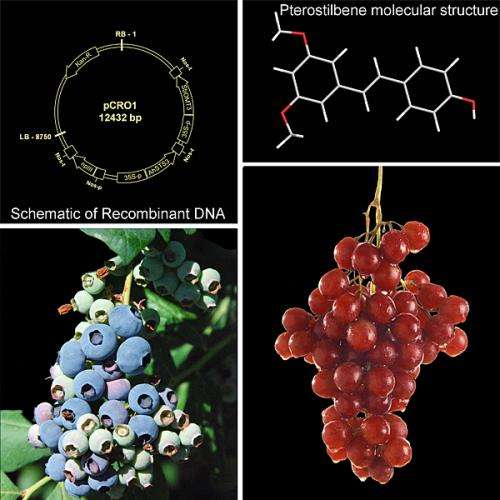Ramping up pterostilbene in crops

A team of U.S. Department of Agriculture (USDA) scientists has developed a way to boost production of a beneficial plant compound called pterostilbene.
The discovery by Agricultural Research Service (ARS) scientists enables crop species to produce or increase production of pterostilbene. Stilbenes are a subgroup of beneficial plant phytochemicals called "polyphenols." The approach could pave the way for ramping up levels of potentially healthful pterostilbene in crops that normally produce it, such as grapes and berries.
ARS is USDA's principal intramural scientific research agency.
ARS molecular biologists Scott R. Baerson and Zhiqiang Pan and chemist Agnes Rimando headed the study. They and plant physiologist Franck Dayan, a coauthor, are with the ARS Natural Products Utilization Research Unit in Oxford, Miss. Another coauthor, ARS plant pathologist James Polashock, works with the agency's Genetic Improvement of Fruits and Vegetables Lab in Beltsville, Md., but is based in Chatsworth, N.J.
There are two stilbenes—resveratrol and pterostilbene—which may possess similar purported beneficial health properties. During their work, the team showed that a previously characterized and patented gene called SbOMT3, which they had isolated from the sorghum plant, is capable of converting resveratrol to pterostilbene. They then built on that conversion activity by co-expressing SbOMT3 with a stilbene-synthase gene, AhSTS3, that had been isolated from the peanut plant.
For the proof-of-concept study, both genes were successfully incorporated into the chromosomes of two different model host plants, Arabidopsis and tobacco. The two-gene strategy generated transgenic plants that were able to produce pterostilbene, the authors reported. The study results were published in Plant Biotechnology Journal in 2012.
An ARS patent, issued in 2010, describes the ability of SbOMT3 to produce transgenic plants that express pterostilbene, and describes the two-gene strategy.
More information: Read more about this research in the November/December 2013 issue of Agricultural Research magazine.
Provided by Agricultural Research Service



















